The Energy-Efficient Home Makeover
No demolition required. A few small tweaks to each room could dramatically shrink your carbon footprint.

It’s no secret that Americans have one of the world’s highest per-person carbon emissions rates—or that much of your personal carbon load can be traced back to a little place called home. In other words, the climate change battleground is even closer than your own backyard. It’s in your bathroom, the kitchen, and the basement, too. So if you’re serious about doing your part to fight climate change, that hybrid or electric car in your driveway is a good start, but it’s not enough. Take a good look at the fixtures and appliances in your home. By making some upgrades, or simply by changing the way you use them, you will reduce your emissions while also saving on your energy bills. Take note of incentives to help lower your costs for these tweaks: the Inflation Reduction Act rewards residents who make all manner of climate-friendly renovations.
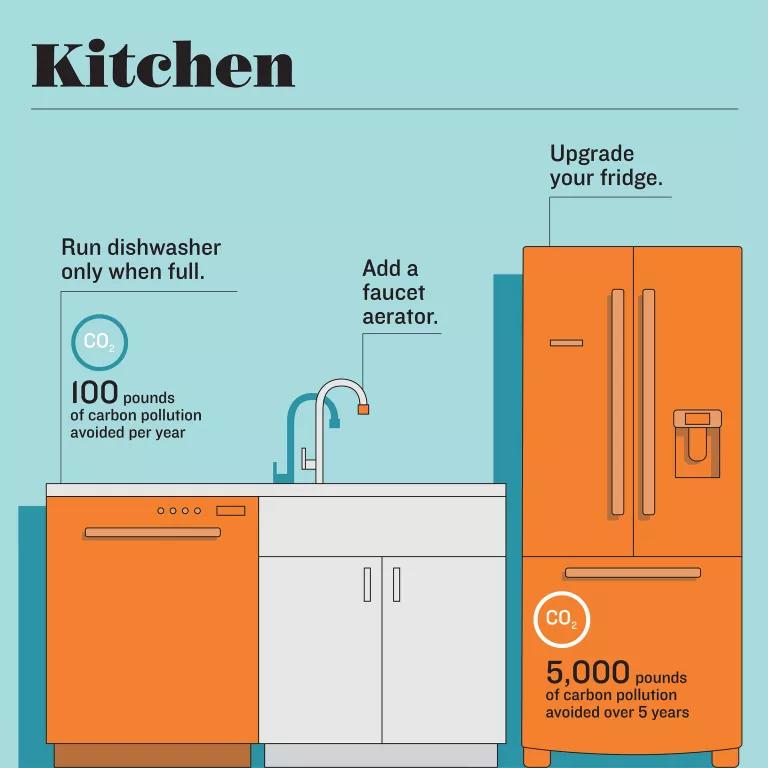
Upgrade your fridge. A new Energy Star–certified model offers major carbon savings. Are you among the one-third of American households with a refrigerator that’s more than 10 years old? If so, replacing it with an Energy Star model could prevent more than 5,000 pounds of carbon pollution over five years. And make sure you recycle your old refrigerator. By making sure that outdated model isn’t reused, you’ll prevent an additional 10,000 pounds of carbon emissions.
Run the dishwasher only when full. If you do this, you could avoid 100 pounds of carbon dioxide pollution per year. The dishwasher also saves you water. It uses as little as 3 gallons per load, while hand-washing that same load can take up to 27 gallons.
Add a faucet aerator. These cheap and easy-to-install fixtures, which screw onto the nozzle of your faucet, reduce your tap’s flow to 1.5 gallons per minute or less from the standard flow of 2.2 gallons per minute. That means they can also save energy by reducing the amount of hot water you use.
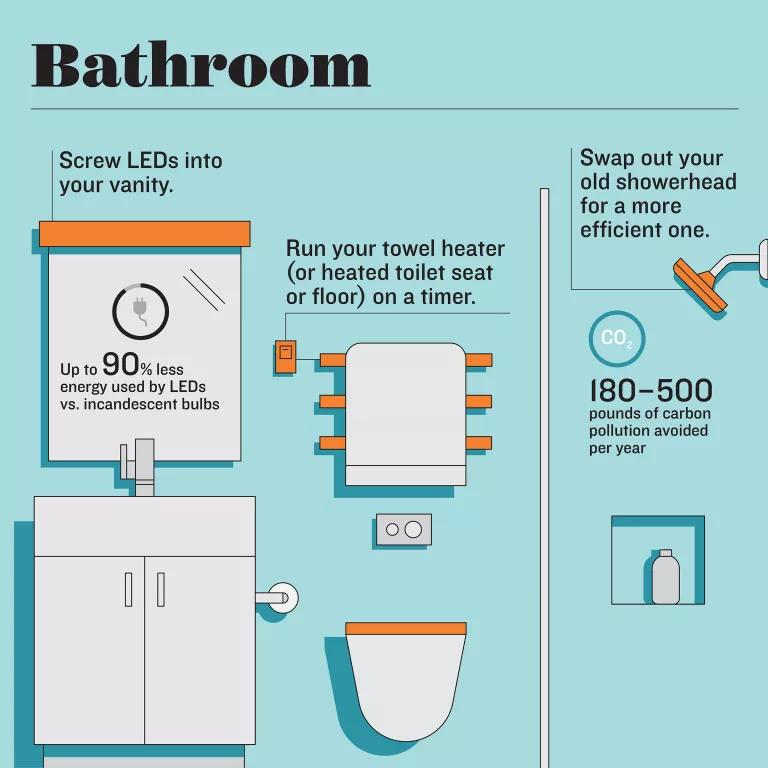
Swap out your old showerhead for a more efficient one. By switching to a WaterSense-labeled showerhead, you’ll save 2,300 gallons of water per year—and lots of energy. With a natural gas water heater, you’ll prevent 180 pounds of carbon dioxide pollution each year; with an electric water heater, the CO2 reduction will amount to 500 pounds per year.
Screw LEDs into your vanity. Some bathroom vanity lighting fixtures come with several round bulbs. If yours use incandescent bulbs, seize this opportunity to maximize energy savings by swapping in LEDs. They use up to 90 percent less energy!
Run your heated towel rack (or floor) on a timer. These increasingly popular bathroom luxuries draw significant amounts of power even when no one is using them—the towel rack alone can consume 140 watts of 24/7 power. (That’s as much energy as your televisions, set-top boxes, and A/V devices are using in standby mode, combined, according to NRDC’s Home Idle Load study).
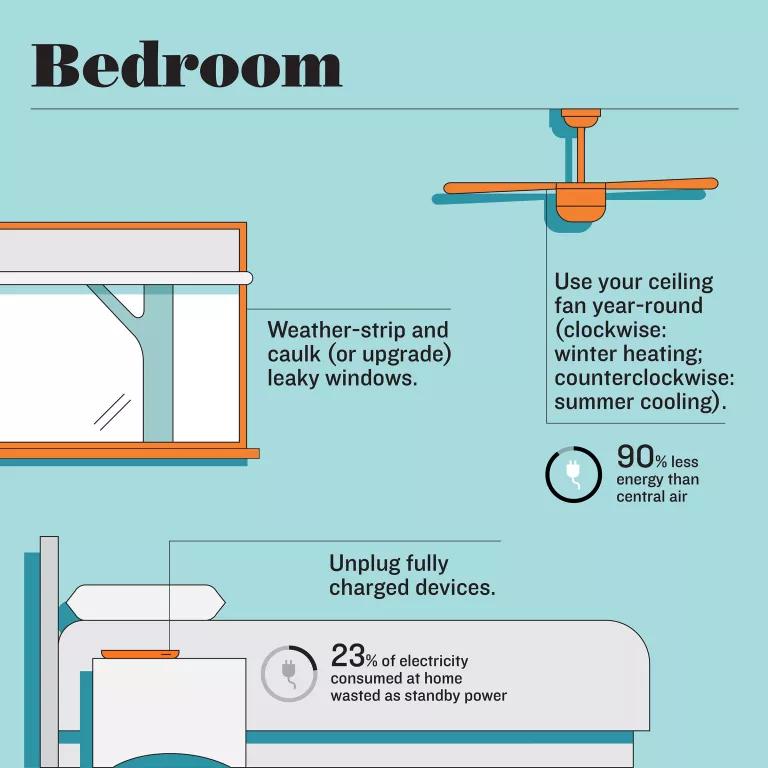
Unplug fully charged devices. Some 23 percent of the electricity consumed in U.S. homes today vanishes as standby power, constantly feeding our perpetually plugged-in phones (or e-readers or tablets). If you can, charge in the morning when you’re getting ready instead of letting them sit fully juiced and still sucking energy through the dead of night.
Use your ceiling fan year-round. Fans can help your bedroom feel up to 10 degrees cooler—and use just 10 percent of the energy consumed by your air conditioner. When practical, using your ceiling fan instead of a window air conditioner could save 1.35 tons of carbon dioxide annually. And don’t think of it just as a cooling device. In cold weather, reverse the direction of your ceiling fan so that it rotates clockwise, pushing the warm air from the ceiling back down into the room.
Caulk and weather-strip (or even better, upgrade) leaky windows. If you're feeling a draft through your windows, weather-strip them and use caulk to plug leaks. You can also use window putty to seal gaps around loose windowpanes. And if you’re renovating, keep in mind that double-paned Energy Star–rated windows yield significant carbon savings as they will reduce both your heating and your cooling bills. As a quick fix, apply low-emissive (low-E) film over drafty windows to reduce heat loss.
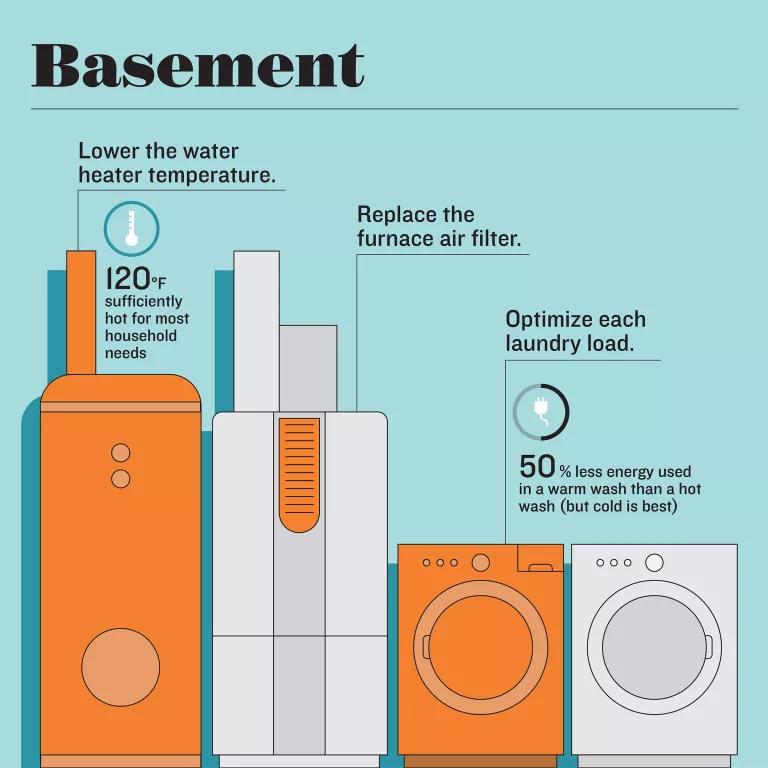
Optimize each laundry load. First, select the cold-water wash setting. Today’s washers and detergents do a great job of cleaning your clothes without requiring hot water. Even if you set your machine’s temperature to warm, it will use half the energy that washing in hot water requires. Also, wait until you have a full load before washing. Finally, with a front loader (which is much more efficient than a top loader), use the high-speed spin setting to remove more of the moisture from your clothes; this cuts down on the energy needed to dry them.
Replace the furnace air filter. Set a calendar reminder to replace the air filter at least every three months. Some filters can be cleaned rather than replaced, so be sure to check. A clean air filter means your furnace won’t need to run as long or work as hard.
Lower the water heater temperature. Many water heaters are set at 140° Fahrenheit, but 120°F is sufficiently hot for most household needs. Seize the opportunity to drop that setting by 20 degrees. On average, hot water production accounts for 18 percent of residential energy use. And don’t forget to dial the water heater temperature way down if you’ll be away for more than a few days. Why spend all that money to heat a tankful of water you’re not going to use?
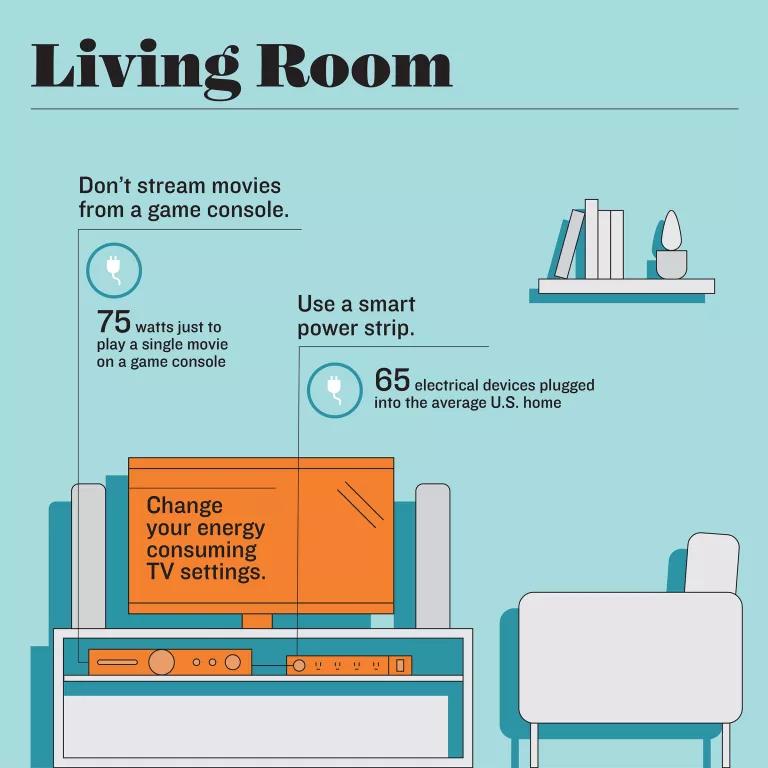
Change your TV settings. If your TV model has an automatic brightness control (ABC) sensor—which adjusts the picture brightness to the level of light in the room—be sure to turn it on. Also, select the normal or standard picture setting; settings like “vivid” can use a lot more energy to produce an overly bright picture.
Don’t stream movies from a game console. These devices are energy hogs when it comes to playing video, using in some cases around 75 watts to play a single movie. There are many low-power streaming devices you can use that will consume closer to 2 watts of energy per movie.
Use a smart power strip. Too much of a hassle to unplug your electronics every time you’re done using them? A smart power strip can turn off all the plugged-in devices at once, fully eliminating their vampire loads.
This story was originally published on October 31, 2017 and has been updated with new information and links.
This NRDC.org story is available for online republication by news media outlets or nonprofits under these conditions: The writer(s) must be credited with a byline; you must note prominently that the story was originally published by NRDC.org and link to the original; the story cannot be edited (beyond simple things such as grammar); you can’t resell the story in any form or grant republishing rights to other outlets; you can’t republish our material wholesale or automatically—you need to select stories individually; you can’t republish the photos or graphics on our site without specific permission; you should drop us a note to let us know when you’ve used one of our stories.


Energy Efficiency: The Clean Facts
What Are Heat Pump Air Conditioners?
What’s the Most Energy-Efficient Water Heater?